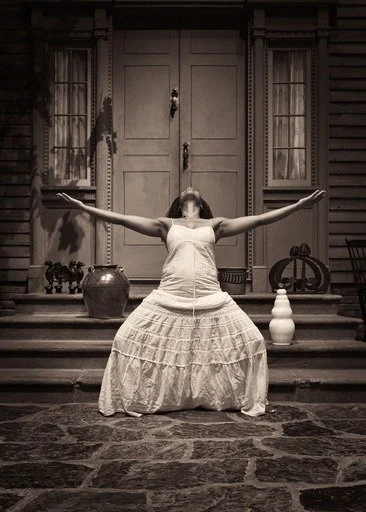Performance Still Images
These images are representative of my exploration of exploring the space between my body and labor, my body and migration, my body and absence, my body and repetitive processes both physically and metaphorically connected to memory and trauma, in discovery of healing and the exploration of discovering and creating new narratives within the context of clay as material culture and history.
Reflection
This body of work is self-discovery, ancestral awakening, meditation, healing, and process. It is past and present, what was and is, the presence of forced labor and free will labor of American Potters.
the vessel to the left of my body was made by David Drake. The vessel to the right top was made by Thomas Commeraw, right vessel, bottom is titled “Vessel for the Ancestors”, made by Tia Santana.
Winterthur Summary
As inviting and appealing as I wished for it to be, I turned down the opportunity to stay on the grounds of Winterthur, my spirit is too sensitive. The time had finally come, Dave’s jar was in the room, and not only would I be in its presence, but I would finally hold the jar in my own hands. In that moment as I held the jar, I experienced three gusts of electrifying waves move through my body. As if the first 2 weren’t confirming, the final lingered affirming its presence. In between wandering and groundedness, I reckoned with the presence as I moved my hands slowly across the vessel, sliding my fingers across the thumbprints of its maker, reaching inside to tickle the ridges made by the pulls of the turner of this historic vessel. I would later connect this particular experience to my exploration of research of the tiny handprints within the brick at James Madison’s estate in Montpellier. The handprints captured and preserved the fingerprints of small enslaved children. Children who labored to build this estate with their own hands. I recalled this moment in comparison to the handprints of the enslaved maker of the pot I held in my hands. There was no respect for persons old or young to the economic demands of slavery. At this moment I reckoned with feelings of amazement within the context of historical preservation, and the gut wrenching sickness at the acknowledgement of the tragedies of slavery. For most of my time on site I would battle my inner conflicting emotions in search of some evidence that would render the entire experience “all worth it”, against the confirmation of facts difficult for comfort and convenience. I was confronting this history both physically, emotionally, and spiritually at the same time in pursuit of academic pedagogy, FYI white people, that's a lot!! To keep it together professionally while falling apart on the inside. Holding a polite smile, processing information in the midst of “the fuck” moments left me both rewarded and drained in the same breath.
I am honored to have had the opportunity to be present with the work of those craftsperson’s that have gone before me. As I prepare for what is next for my practice, I am affirmed by the physical presence of the work of my ancestors.
How do we present the work of black makers? How do artists such as myself reference the past and not be bound by it? How do black artists that encounter the trauma of an object speak to the object in the present while preserving the historical context of the object? How do we diversify the way in which we receive, examine and process information without the weight of “othering” or “imposter syndrome”? For us as Black Americans we must be allowed the space to grieve and process the hurt so that we can fully extend ourselves as we expand into the joy of our past and present. There is joy to be found, to be experienced, to be had, to be felt, to be encountered, to be processed, to be revealed if not but for a fleeting moment there is joy to be encountered.



